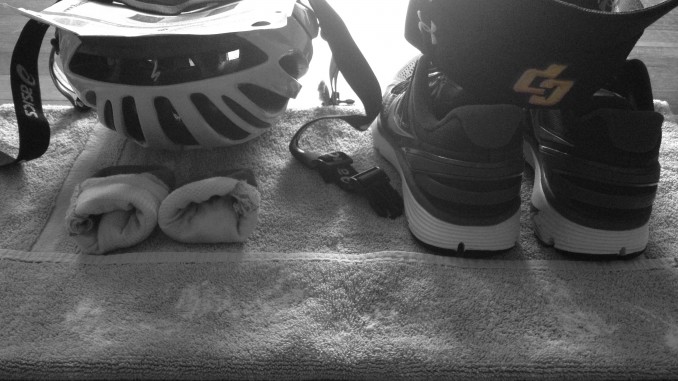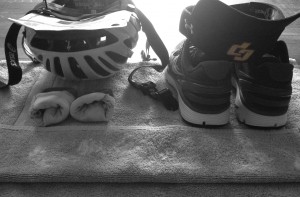

For the triathlete, cutting transition times can be key to moving up a few positions in the overall standings. I know a few people who are really strong racers, but their T1 and T2 times add over 10 minutes to their overall placing. When it comes time to drop that wetsuit and hop on the bike, don’t dawdle around refitting your helmet. Get in, swap your kit, and get out! Here, I’ll explain just how to set up your transition area for a quick change, and a faster overall time.
Before I go into the secrets to the perfect transition, I need to confess something. During my last tri, racing in the collegiate category and against a major school rival, I arrived barely 5 minutes before the transition area closed. I basically tossed my stuff down, and called it good. It was rather chilly that morning, so I wanted socks and arm warmers ( yes, with a sleeveless tri suit *cringe*). Without a careful check of my gear, it all looked set up the way I’ve done it several times before.
I made my wave in time, swam a pretty good pace, and headed to T1. I rolled on my socks, pulled my arm warmers onto my wrists, gathered the rest of my gear and was off. About 10 miles into the bike ride, a rival team member passed me going the other way and snickered. I thought, “Whatever, dude, I’m so awesome.” Then I looked at my arms–one of my striped arm warmers had stripes going the wrong way. It was inside out and upside down. In my hurry, I didn’t even notice, but others totally did. I stripped off the warmers, and braved the cold for the rest of the ride. Finally, I got back to T2–pulled my shoes on and started running. A mile or so down the road, my right foot start to feel blistered and uncomfortable. I checked it, and, sure enough, my sock was on upside-down–the heel at my instep. It wouldn’t have been too bad except I happened to be wearing crew-length socks with logos on the back (or in my case, one on the back and one on the front). This did not make me feel very cool. Also, how would I explain the black asphalt stains on the top of my sock?
Why did these things happen to me? Because I wasn’t careful in my transition setup. I rolled my socks to get them on faster, but failed to check that they were both right-side-up. Same with my arm warmers. The moral: get to the race early. Don’t be rushed. And above all, double-check your gear!
Terrific Transitions
Instead of going through all the steps in writing, it’s much easier to explain transitions through a video. Below, I’ve linked to one of the best videos I’ve seen for breaking down the process. But the soft-spoken Englishman does mention a few tips that I might do differently:
- Just wear socks! If you’ve been racing triathlon for a while and enjoy the moist cold feel of cycling and running in bare feet, go right ahead and suffer. But I’d rather take the extra ten seconds and keep up with comfort. A quick tip though: put your sock on, then roll it off your foot and leave it rolled open on your transition towel. That way, you will make sure it’s right-side-up and slide it on easily.
- Dont rack your bike by the brake lever as the young man does in the video. Remember that other people may jostle your bike, and the stress on the lever may throw off your shifting, or worse, break the lever. That’s a pretty expensive way to save a few seconds.
- I’m not sure where the bin nonsense comes in, but don’t expect much extra room around your transition area. There will likely be stations on both sides of the rack, and just a little space for your transition towel. If you have an extra bag, leave it with your friends and family who are spectating.
- Lastly, I’ve never worn a race belt under my wetsuit. If you want to do it, more power to you, but some race bibs are not totally waterproof. Also, buckles inside a fragile and skin tight wetsuit don’t seem like a good combination. But I could be wrong …
And don’t forget to practice before race day! Especially if you’re trying the flying mount.
http://youtu.be/50AzTJClfWc

Leave a Reply